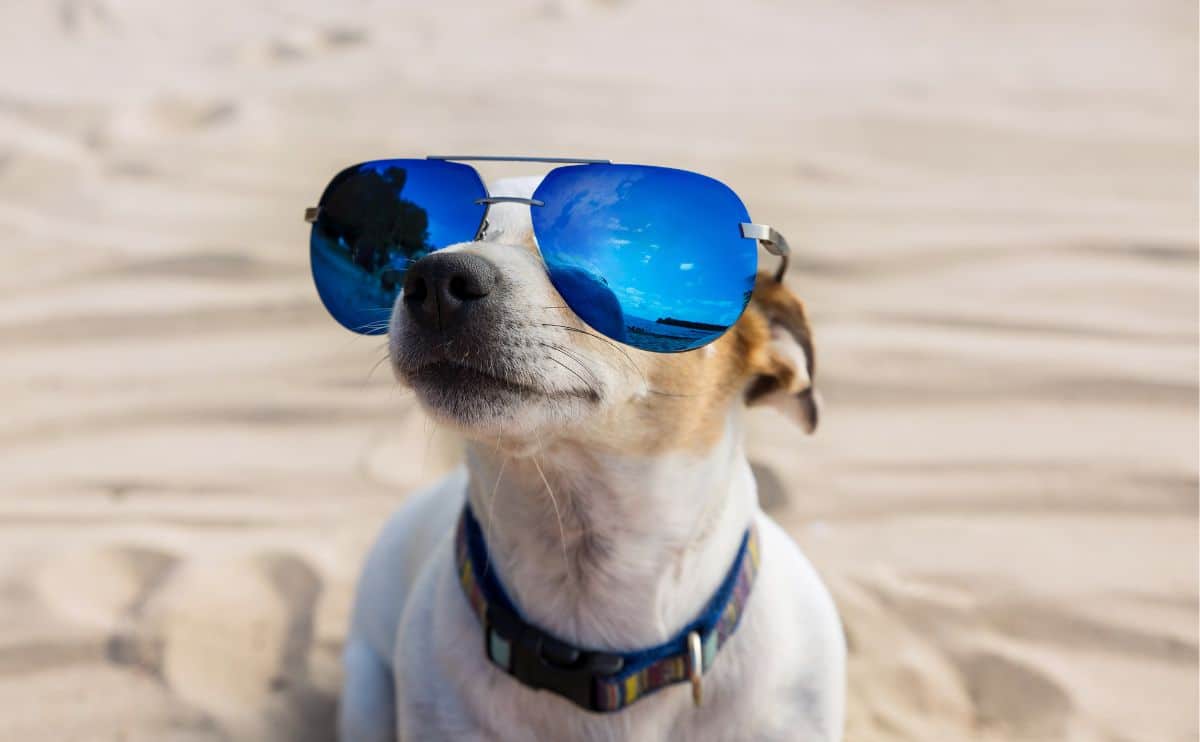Holiday Hazards for Pets You Didn’t See Coming (Until the Vet Bill Hit)
When you purchase through links on our site, we may earn a commission. Here’s how it works.
You’re hanging stockings. Your dog’s eyeing the dessert table like it’s an Olympic event. The lights are twinkling, the music’s playing, and they’re about two seconds from eating something that’ll cost you a small fortune at the vet.
Table of Contents
Here’s how to keep your holiday merry, bright, and vet-bill free.
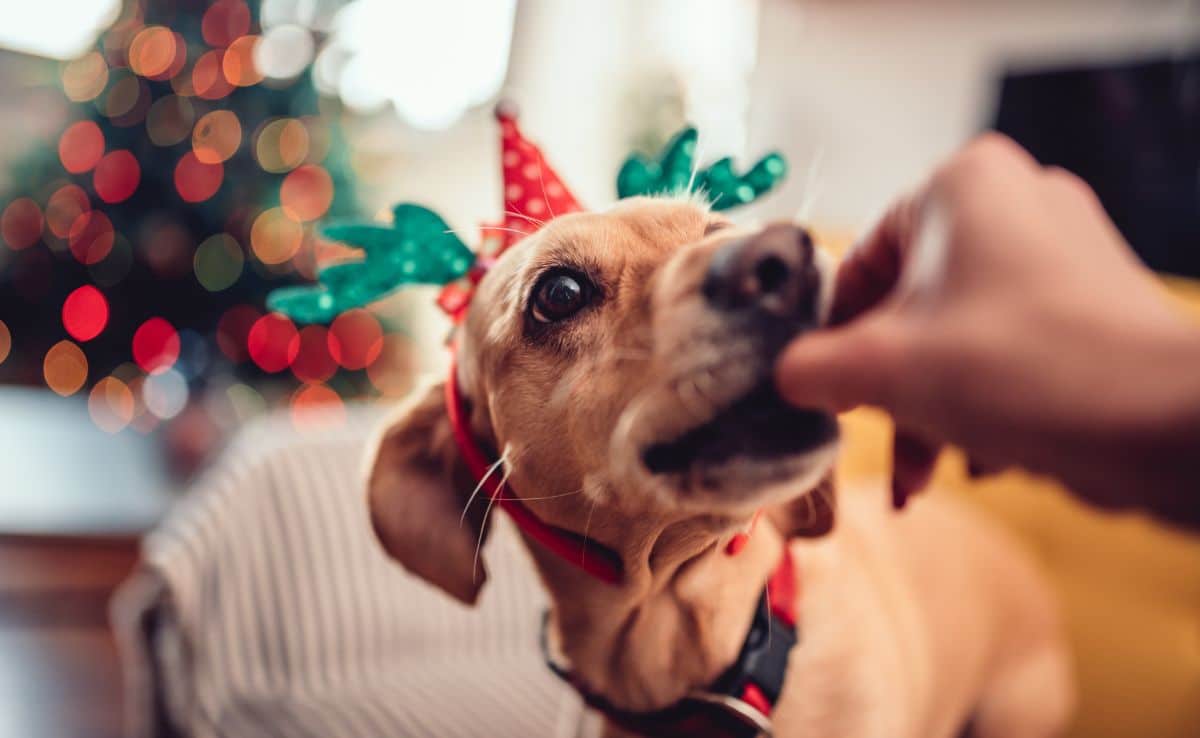
4 Food Hazards
Delicious for You, Deadly for Dogs
The holidays are basically an endless buffet of smells, sauces, and snacks. Every countertop becomes a temptation zone, and your dog’s nose knows exactly where the action is.
But those “harmless little tastes” can turn into a night at the emergency vet faster than you can say leftovers. Understanding which foods are risky and why is the easiest way to keep your pup safe while everyone else feasts.
1. Chocolate
The Tastiest Disaster Waiting To Happen
Few foods spell trouble for dogs faster than chocolate. It contains two caffeine-like stimulants, theobromine and caffeine, that dogs can’t metabolize properly. The darker and purer the chocolate, the higher the concentration of toxins.
What starts as a “funny moment” of a missing cookie can quickly turn scary: restlessness, drooling, vomiting, rapid heartbeat, and even seizures. Some dogs show symptoms within an hour, others after several.

Size matters too. A small dog eating a single brownie can face the same danger as a large dog devouring a few squares of baking chocolate.
If your dog gets into chocolate, don’t wait for signs to appear. Call your vet or a 24-hour animal poison line immediately. The sooner treatment begins, the better the odds of a full recovery.
Quick Takeaway:
- The higher the cocoa content, the higher the danger.
- Baking and dark chocolate are the worst offenders.
- Call a vet immediately after ingestion, because time truly counts.
2. Xylitol
The Sweet Treat That Can Kill in Minutes
The holiday season practically runs on peppermint bark and sugar-free candies. Unfortunately, many “guilt-free” treats contain xylitol, also listed as birch sugar or birch sap on ingredient labels.
To humans, it’s a low-calorie sweetener. To dogs, it’s an immediate medical emergency.
Xylitol triggers a surge of insulin that causes blood sugar to crash dangerously low within minutes. Vomiting is generally the first symptom, followed by collapse, seizures, or even liver failure within a few hours.
The scary part? It doesn’t take much – a stick of gum or a cookie made with xylitol can be enough.

Peppermint is also a toxic substance for dogs. So it is best to keep candy canes out of canine reach for several reasons.
If your dog eats anything labeled sugar-free, assume it’s unsafe until you confirm the ingredients. Symptoms come on fast, so don’t “wait and see.” Rush your dog to a vet or emergency clinic right away.
Quick Takeaway:
- Avoid sugar-free gum, mints, peanut butter, and baked goods unless verified xylitol-free.
- Learn to spot alternative names like birch sugar.
- Seek immediate veterinary help if consumed.
3. Fat Trimmings & Bones
A Costly Vet Bill Mistake
Dogs beg for turkey scraps with Oscar-worthy eyes, and it’s almost impossible to resist. But greasy trimmings and bones are behind thousands of holiday vet visits each year.
The American Veterinary Medical Association (AVMA) warns that “cooked chicken, turkey, and other soft bones can splinter and damage your pet’s mouth or digestive system.”
Fatty meats overwhelm a dog’s pancreas, causing painful inflammation known as pancreatitis. Bones, especially cooked ones, splinter easily and can lodge in the throat, pierce intestines, or block digestion entirely.
If you want to treat your pup, stick to lean, unseasoned meat or specially formulated dog chews, like bully sticks. Keep bones, gristle, and table scraps in a dog-proof trash can, as they can smell food through plastic.
Just check out Atlas’s story in the video below and his $7,000+ in vet bills!
Quick Takeaway:
- Skip both cooked and raw bones, as they can break or splinter.
- Avoid greasy leftovers; they can trigger pancreatitis.
- Trash cans with bones should be secured.
- When in doubt, offer dog-safe treats only.
4. Holiday Drinks
Drinks Your Dog Should Never Sip
Between eggnog, mulled wine, cocoa, and spiked punch, the holidays are a beverage bonanza, and dogs want in. Unfortunately, even small amounts of alcohol, caffeine, or rich dairy drinks can be toxic.
Alcohol causes vomiting, disorientation, and dangerously low body temperature; caffeine leads to rapid heartbeat and tremors; heavy cream or milk can cause digestive distress in lactose-intolerant dogs.

Picture this: you set down your mug of hot cocoa, step away for a minute, and come back to find your dog licking the rim. That tiny taste could lead to a long, uncomfortable night.
It’s safest to treat any spillage or “taste test” as an emergency.
Quick Takeaway:
- Keep all alcoholic or caffeinated beverages out of reach.
- Skip giving your dog eggnog and cocoa; both mix sugar, dairy, and toxic ingredients.
- Stick to water; your dog’s favorite drink is already vet-approved.
Bonus: 4 Safe Holiday Snacks for Dogs
If it’s rich, sweet, or smells amazing to you, it’s probably a no-go for your dog. Think of moderation and simplicity as the best gift you can give them this season.
So, when everyone else is snacking, your dog doesn’t have to miss out. Just keep it simple:
- Plain, cooked sweet potato or pumpkin
- Steamed carrots or green beans
- A small piece of unseasoned turkey breast
- Dog-specific holiday treats made without sugar or fat

Every December, my kitchen turns into a mini bakery as my toddler and I whip up DIY Christmas cookies and biscuit candy canes for our dogs, Bonkers and Chips.
We use dog-safe ingredients, and the treats look (and smell) just as festive as the human kind. It’s my toddler’s favorite holiday activity, fun, messy, and full of tail wags. Plus, the cookies make adorable gifts for our dog-owning friends, too.
Wait, Did Your Dog Just Eat That?!
Before you panic (or Google “can dogs eat stuffing?” for the tenth time), check out our full guide, The Ultimate List of Foods Poisonous to Dogs. Your wallet will thank you, your vet will thank you, and your dog… well, they’ll just keep trying anyway.
3 Decoration Hazards
When Holiday Cheer Turns to Chaos
Every December, homes transform into glowing wonderlands, and to your dog, that wonderland looks like a playground of chew toys, shiny snacks, and dangling surprises.
Unfortunately, the very things that make your living room sparkle can turn into serious hazards faster than you can say “leave it.” Here’s how to decorate smart without ending up at the emergency vet.
1. Tinsel, Ribbons & Ornaments
Shiny But Deadly
Tinsel is like a glittery snake; it moves, it sparkles, and to dogs, it looks irresistibly fun to grab. But once swallowed, it can twist through their intestines and cause blockages that require surgery. The same goes for curling ribbons, bows, and metallic wrapping strands.
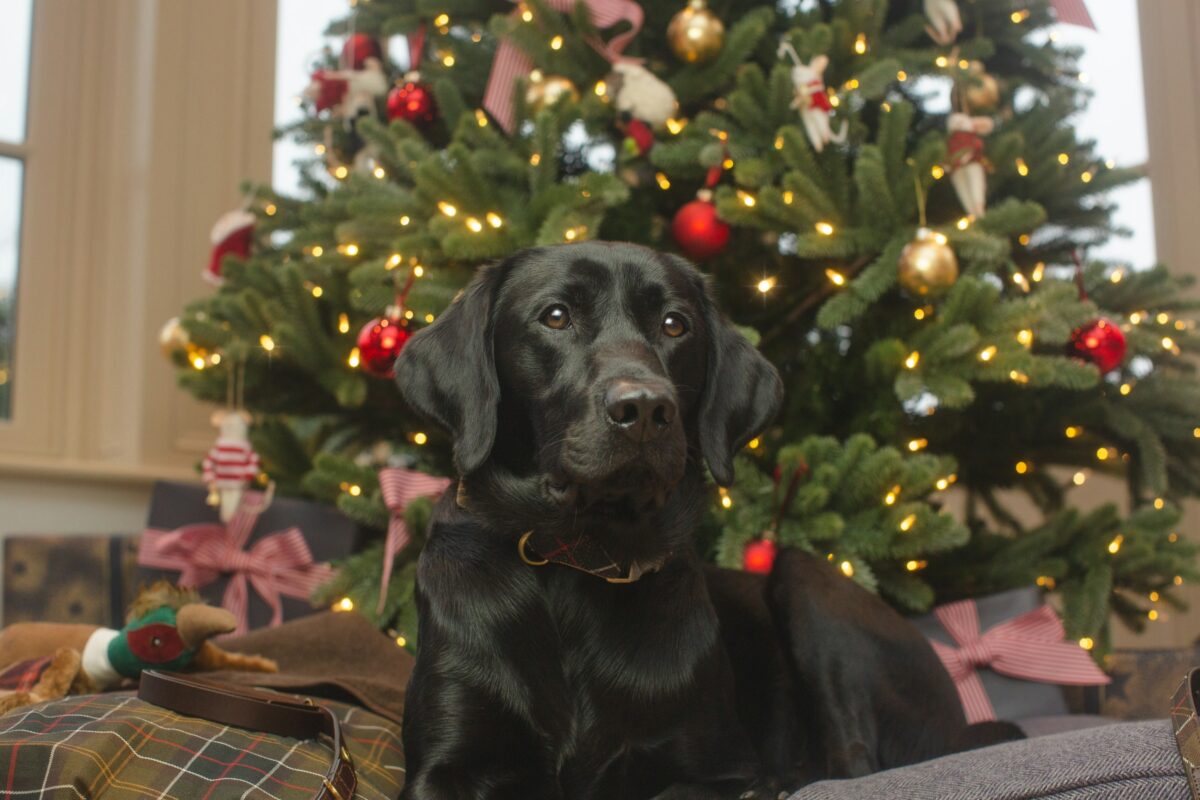
Glass ornaments are another hidden danger. They look like toys, and when they fall, they shatter into razor-sharp shards. Dogs can cut their mouths, paws, or throats trying to “play” with broken pieces. Even plastic or soft ornaments can cause choking if chewed or swallowed whole.
If your dog can reach it, they’ll test it, so hang fragile decorations high, skip tinsel altogether, and store ribboned gifts out of reach until it’s time to unwrap.
Quick Takeaway:
- Avoid tinsel, ribbons, and glass ornaments at dog level.
- Replace fragile décor with shatterproof or felt ornaments.
- Supervise gift opening because dogs love to “help” unwrap.
2. Christmas Lights & Candles
Shockingly Bad Ideas
A strand of twinkling lights can turn your home into a Hallmark card, but to a curious dog, those cords are basically spaghetti. Chewing on lights can cause electrical burns, mouth injuries, or even fatal shocks.
Loose cords also pose a strangulation risk if your dog gets tangled while playing. So, check all wiring before decorating, and use cord protectors or tape to secure them out of reach.

When it comes to candles, real ones might set the mood, but wagging tails and flickering flames are a dangerous mix. A single bump can knock a candle onto the floor or nearby fabric, starting a fire before you even realize it.
Quick Takeaway:
- Tape or cover cords, and unplug when you’re not home.
- Keep all candles up high or use flameless ones.
- Never leave lights or candles unattended near pets.
3. Gift Wrap, Toys & Batteries
Small Stuff, Big Trouble
Wrapping paper might seem harmless, but dogs love shredding things and swallowing pieces in the process. Ribbon, tape, and string can get lodged in their intestines, while small toys or plastic pieces from packaging can block airways or digestive tracts.
Batteries are a newer but equally dangerous issue. Holiday toys, remote controls, and twinkle light remotes often use small lithium coin batteries.
If swallowed, they can leak acid and burn through tissue within hours. This is a genuine emergency, not a “wait and see” situation.
Keep all packaging supplies in closed bins, unwrap gifts away from curious noses, and clean up immediately afterward. Make a habit of checking the floor before bedtime, because those tiny bits of ribbon or paper can turn into an expensive mistake.
Quick Takeaway:
- Keep wrapping paper, bows, and toys out of reach.
- Store batteries securely and discard used ones safely.
- Always clean up packaging before letting your dog roam.
Bonus: Make Décor Dog-Friendly
Decorating with dogs in mind doesn’t mean skipping the sparkle altogether. Try soft garlands made from fabric, sturdy wooden ornaments, or large, non-breakable décor. Use pet-safe essential oils or sprays to deter chewing near cords or the base of the tree.
If you have an especially curious pup, create a “dog-safe zone” – a small section of the house with soft lights and decorations they can sniff or enjoy safely. It satisfies their curiosity while keeping them away from the dangerous stuff.
A Real-Life Fix: The Olive Tree Christmas Hack
One of our team members swaps out the traditional pine for a tall olive tree every year, and it’s genius, and it still feels festive. So, if you’ve got a curious pup or limited space, consider this low-risk, dog-friendly holiday upgrade.
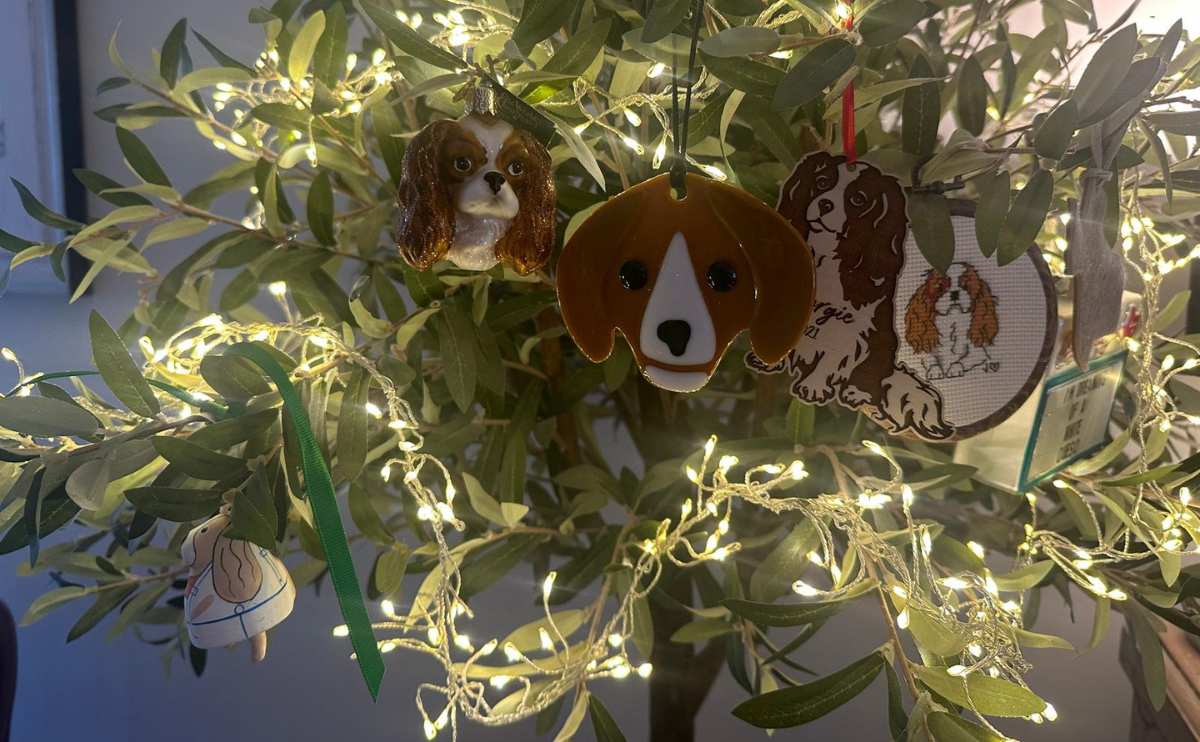
We have a fake olive tree that becomes our Christmas tree every year, and it is in a pot with a long trunk, so the part where we decorate with (mostly) dog ornaments and lights is way above our dog’s sight and reach.
– Sadie Cornelius, Dog Mom & long-life friend of Canine Journal
6 Plant & Poison Hazards
Festive Greens That Can Poison Your Pup
Holiday plants make homes look warm and cozy, but many traditional greens are toxic to dogs. Those bright reds, glossy leaves, and fragrant branches are holiday staples and irresistible to a curious nose.
Unfortunately, even a few bites or licks can lead to stomach upset or a frantic trip to the vet. Here’s what to watch out for.
1. Poinsettias
Pretty But Problematic
Poinsettias are practically the mascot of December décor, but they’re not as harmless as they look. Their signature red leaves (technically bracts) contain a milky sap that can irritate a dog’s mouth, throat, and stomach.
While the effects are usually mild, symptoms like drooling, pawing at the mouth, vomiting, or diarrhea can still ruin your evening.
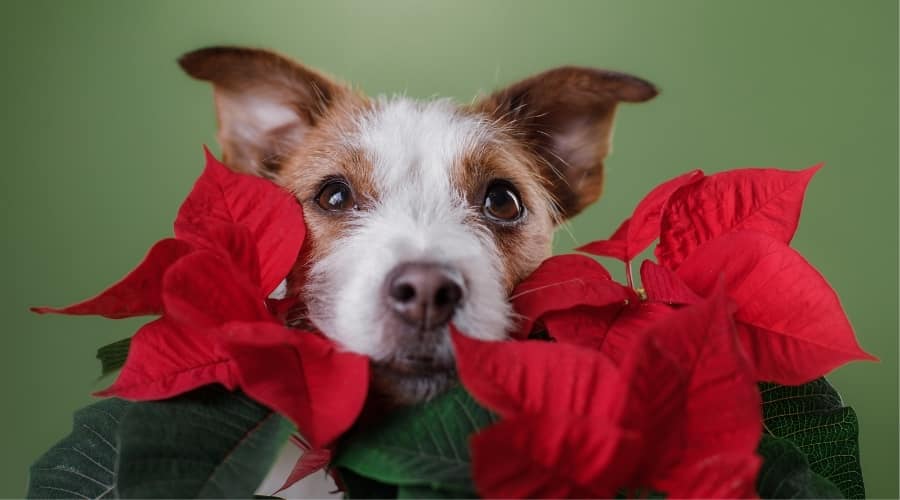
The American Kennel Club (AKC) clarifies that poinsettias are “only mildly toxic” to dogs, meaning your pup will likely recover quickly with supportive care, but that doesn’t mean it’s worth the risk.
Quick Takeaway:
- Keep poinsettias out of reach.
- Even mild irritation can cause vomiting and drooling.
- When in doubt, call your vet for advice.
2. Pine Needles
The Hidden Tree Trouble
That real Christmas tree smell? Your dog loves it just as much as you do, maybe too much. Pine needles can puncture the digestive tract if swallowed or irritate your dog’s mouth and gums. Pine oils may also cause drooling, vomiting, or lethargy.
Vacuum regularly, and make sure your dog can’t sneak sips of the tree’s water. Artificial trees are safer, but they come with their own risk: tiny plastic “needles” can cause blockages if ingested.
Quick Takeaway:
- Sweep or vacuum needles daily.
- Prevent chewing near the tree base.
- Consider a barrier or decorative fence around the tree.
3. Holly
The Bright Berries That Bite Back
Holly berries look festive, but they’re no treat for dogs. Both the leaves and berries contain saponins, which irritate the stomach and can lead to vomiting, diarrhea, or drooling. Some dogs also experience lethargy or loss of appetite afterward.
Many veterinarians advise against using real holly entirely if you have pets. Even a small nibble can cause an upset stomach, and dried holly used in wreaths can be just as harmful.
Quick Takeaway:
- Avoid live holly plants indoors.
- Dried holly is still toxic if chewed.
- Replace with artificial holly made from fabric or paper.
4. Mistletoe
Small Plant, Serious Consequences
Mistletoe might be romantic, but it’s one of the most dangerous holiday plants for dogs. American mistletoe contains compounds that affect the heart and nervous system.
Ingesting it can lead to vomiting, diarrhea, difficulty breathing, slowed heart rate, or even collapse in severe cases. The ASPCA lists mistletoe as toxic to both dogs and cats, noting that large ingestions can be life-threatening.
If you love the tradition, hang a faux version high enough that no pup can reach it.
Quick Takeaway:
- Skip real mistletoe altogether.
- Artificial versions are safe and look identical.
- Seek veterinary help immediately if eaten.
5. Christmas Tree Water
The Hidden “Drink” That Makes Dogs Sick
Dogs love to sneak a sip from the base of a Christmas tree, but that stagnant water can contain pesticides, fertilizers, or preservatives used to keep the tree fresh.
Over time, bacteria also grow in the water, making it even more dangerous. Ingesting even small amounts can cause vomiting, loss of appetite, or lethargy.

To be safe, cover your tree stand with foil, a tree skirt, or a plastic lid. Replace the water frequently and block your dog’s access entirely if they’re prone to investigating.
Quick Takeaway:
- Keep the tree water covered or inaccessible.
- Replace it regularly to prevent bacteria buildup.
- Clean spills immediately to prevent lapping.
6. Ice Melt & Rock Salt
Winter’s Hidden Paw Poison
Not all holiday hazards grow in pots. Ice melt and rock salt, used to clear icy sidewalks and driveways, are another major winter risk.
When dogs walk on salted surfaces, the crystals can irritate their paw pads. If they lick their paws afterward, they may ingest harmful chemicals, leading to vomiting or electrolyte imbalances.
The AVMA recommends using pet-safe de-icing products labeled as “chloride-free” or “non-toxic.” After walks, always wipe your dog’s paws and belly with a damp cloth to remove residue.
Quick Takeaway:
- Choose pet-safe ice melt products.
- Rinse paws after every winter walk.
- Store bags of salt securely out of reach.
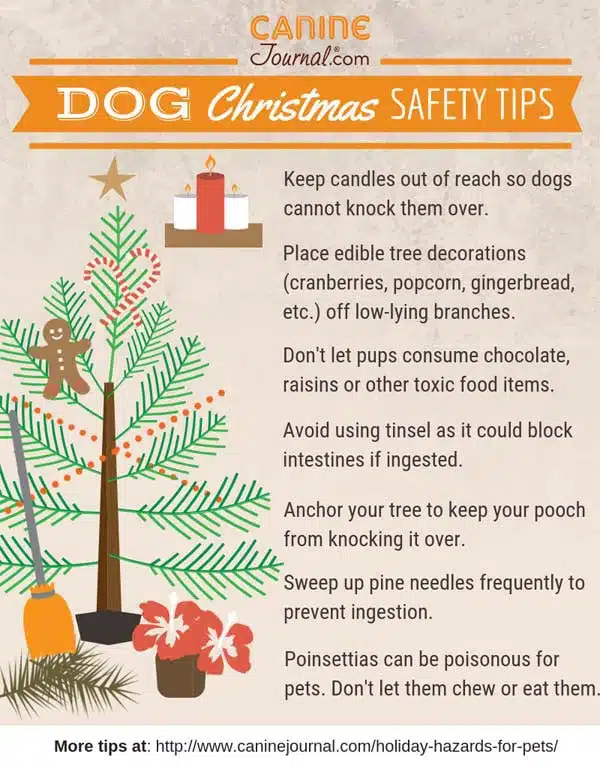
5 Holiday Chaos Hazards: The Sneaky Stuff Nobody Warns You About
The holidays aren’t just about food, decorations, and plants. They’re also full of noise, guests, and sudden bursts of activity. While we’re busy wrapping gifts and juggling schedules, our dogs are trying to make sense of it all.
For many pets, the season’s excitement can quickly become overwhelming or even dangerous.
1. Open Doors & Escape Artists
Holiday gatherings mean people coming and going constantly, and that means doors opening every few minutes. It takes only a second for an excited or anxious dog to slip through and bolt outside.
The mix of loud noise, new scents, and strangers can easily trigger an escape attempt. Even well-trained dogs can panic when fireworks pop or a room full of guests cheers for a gift exchange.
Make sure collars fit snugly and that tags are updated with your current phone number. Microchipping adds another layer of security if your dog manages a great escape.
You can also set up a quiet “safe zone”, a spare room, crate, or gated area where your dog can relax while guests come and go. Let visitors know to keep doors shut and resist the urge to let your pup run loose during the festivities.
Quick Takeaway:
- Keep doors closed or use baby gates during parties.
- Ensure collars and tags are current and secure.
- Create a calm, quiet retreat for your dog during gatherings.
2. Noise, Guests & Travel Stress
Even the happiest dogs can get stressed during the holidays. Sudden changes to routine, loud noises, fireworks, or unfamiliar guests can make your dog anxious or reactive. Some dogs hide; others pace, whine, or bark more than usual.
If you’re hosting, provide a quiet space away from guests where your dog can decompress. Soft bedding, a favorite toy, and gentle background music (like low-volume TV or calming playlists) can make a big difference.

If you’re traveling, bring familiar items such as their bed, blanket, or a shirt that smells like home to help them feel secure.
Dogs pick up on human stress, too. When things get hectic, take a few minutes to check in with your pup. A short walk or play break not only helps them but also gives you a breather.
For dogs with severe anxiety, talk to your vet before the holidays. They may suggest calming supplements, pheromone sprays, or temporary medications to ease stress.
Quick Takeaway:
- Stick to routines as much as possible.
- Give dogs a quiet retreat during noisy events.
- Consult your vet about anxiety options if needed.
3. Traveling With Dogs During the Holidays
Whether it’s a long road trip or a quick drive to Grandma’s, traveling with your dog takes planning. Sudden travel can cause stomach upset, stress, or motion sickness.
Always secure your dog with a seat belt harness, crate, or carrier. Loose dogs can be seriously injured in sudden stops or turns. And pack a travel kit with essentials: food, water, leash, waste bags, and any medications.
If you’re crossing state lines or visiting family, make sure your dog’s ID tags are up to date and that you have their vaccination records handy.
When staying in someone else’s home, establish ground rules early. Not everyone is used to a curious snout exploring under their tree or sniffing the dessert table.
Quick Takeaway:
- Buckle or crate your dog during car rides.
- Bring familiar items and essentials to reduce stress.
- Be courteous to hosts by keeping dogs supervised.
4. Fireworks & New Year’s Noise
Just when your dog thinks the holidays are over, the New Year’s fireworks begin. The loud bangs and flashes can terrify even confident dogs. Some try to hide; others shake, pant, or try to escape.
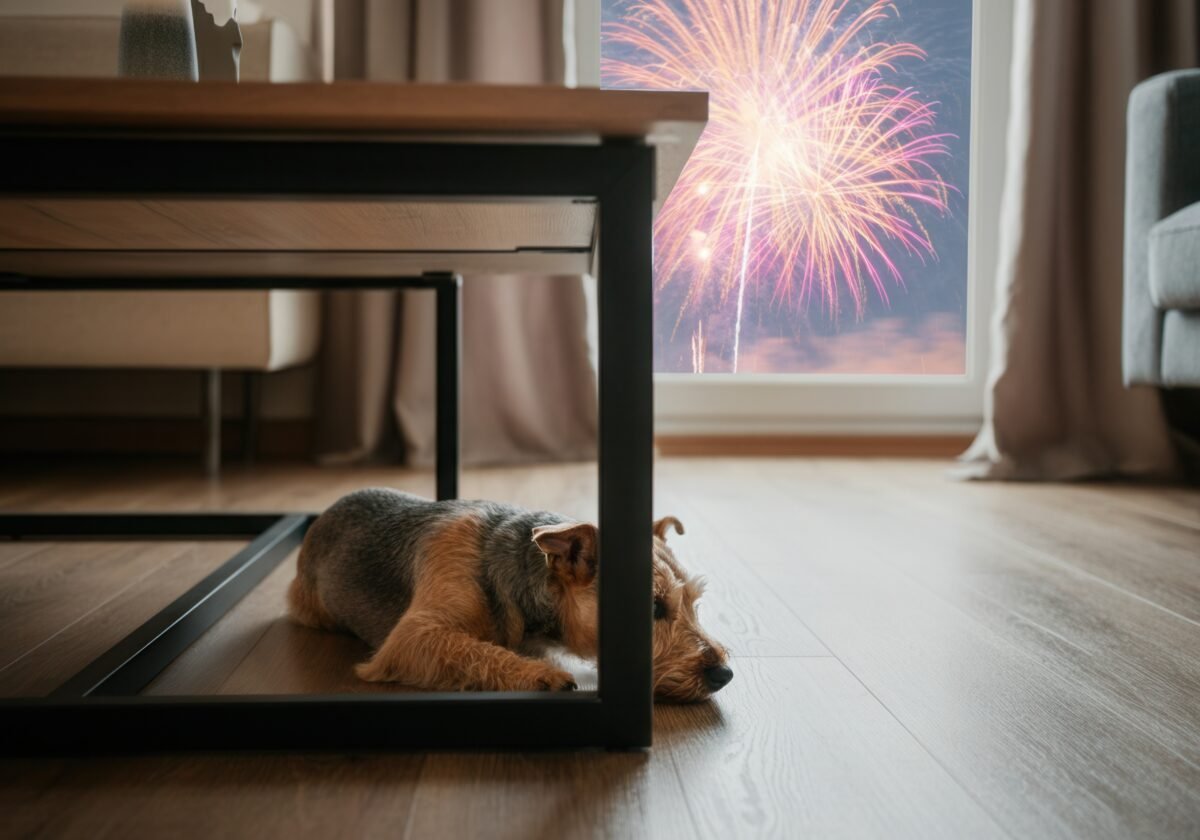
Close windows and curtains to reduce the noise and light. Turn on the TV or some calming music to help mask outside sounds. Never take your dog outside during fireworks unless they’re leashed and supervised, because even the calmest pets can bolt in fear.
If your dog struggles badly with fireworks, talk to your vet ahead of time. There are safe, vet-recommended treatments and anxiety aids that can make the night much less stressful.
Quick Takeaway:
- Keep dogs indoors during fireworks.
- Use background noise to mask booms and flashes.
- Ask your vet about calming treatments if needed.
5. Visitors & Holiday Hazards You Might Miss
Sometimes it’s not the big stuff but the little things that cause trouble. Guests leaving bags open, purses full of gum or medication, or food left within reach on a coffee table.

Dogs don’t know what’s safe and what’s not; they just know it smells amazing. Politely remind guests to keep their belongings closed and food out of reach.
If you have children visiting, keep toys with small parts or batteries stored high. A quick “pet safety check” before gatherings can prevent most emergencies.
Quick Takeaway:
- Ask guests to store food and bags safely.
- Keep small objects, toys, or medication out of reach.
- Double-check the floor and tables before bedtime.
How Can Pet Insurance Help?
The holidays are full of surprises, and not just the wrapped kind. Between chocolate mishaps, swallowed ornaments, and late-night vet runs, it’s one of the busiest (and priciest) times of year for pet emergencies.
A single emergency visit can cost hundreds or even thousands of dollars, but insurance can help cover those unexpected costs so you can focus on your dog, not your bank balance.
Want to learn more? Check out our guide to the Best Pet Insurance For Dogs to see how affordable coverage can be and help you find the right option for you. You can also use our free quote tool below.
Keep the Holiday Cheer (and Your Dog) Going
You’ve mastered the art of keeping your dog safe this holiday season, now let’s make it fun. Check out our guide to the best Christmas gifts for dogs to find toys and treats they’ll actually love (and won’t land them at the vet).
Curl up with your pup and our list of the best holiday movies to watch with your dog for a cozy night in, or burn off those extra cookies with our holiday fitness tips for you and your dog.
And if you’re thinking about getting a Christmas puppy, don’t miss our advice on how to prepare your home and your heart for the newest member of your pack.
Share Your Holiday Tail! We know every dog has their own version of holiday chaos, from stolen turkey legs to toppled trees. We’d love to hear yours! Drop your funniest, sweetest, or most “oh no” holiday pet stories in the comments. So, go on, tell us: what did your dog do last Christmas?



